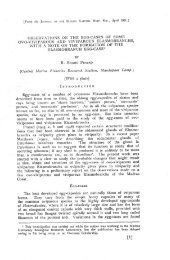PDF - Eprints@CMFRI
PDF - Eprints@CMFRI
PDF - Eprints@CMFRI
Create successful ePaper yourself
Turn your PDF publications into a flip-book with our unique Google optimized e-Paper software.
168<br />
Primaries and secondaries unite with the columella without any fusion. The fifth, fourth and third unite<br />
and reach the columella. Septa very little exsert, steeply descending. Primaries and secondaries thickened<br />
at the wall , a little broader above than below. Edges of major septa entire, those of higher cycles serrated.<br />
Septa perforate behind. Septal sides granular. Columella in a large corallite less than 1 mm broad and<br />
about half the diameter of the calyx long, not projecting, suggesting septal fusion. Costae with rows of<br />
rounded granules extend to the base of the corallites, which is mostly covered by a thin epitheca.<br />
Mate rial :<br />
Gulf of Aqaba:<br />
Jerus.<br />
T. Aviv<br />
SLR<br />
NS<br />
647 (Marsa Abu Zabad).<br />
E55 /149 I, 55 1156, 55 /213 (Eilat) ; 1844 (Shu rat al Manqata); E57/227<br />
(Marsa Abu Zabad).<br />
Northern R. S.: Jerus. SLR 1658 (Ras Nasrani).<br />
T. Aviv S 5931 (Ras Muhammad).<br />
Central R. S.: P. Sud. Sa 86a (Sanganeb R.).<br />
HLM RM 98 (Wingate R.).<br />
Dis t rib uti 0 n : Red Sea ; Seychelles.<br />
. Rem ark s: Rbodopsommia affinis (SEMPER, 1872) is very near to the present species. The major<br />
dlffe~ence seems to be In the nature of the columella. i. e. in R. affinis it is projecting, while in B. gemmifeTa<br />
It IS small and level. KLUNZINGER (1879) obviously has not consulted SEMPER'S work (1872), as<br />
far as one can understand from the list of literature cited by KLUNZINGER . Another species that might<br />
ultimately prove to be similar to the present species is DendTopbyllia serpentina VAUGH A ,1907.<br />
Balanopbyllia diffusa HARRISON and POOLE , 1909<br />
Balanopbyllia diffusa 1909, HARRISON & POOLE. 906: pI. 85/4., b (Type locality : Hastings Harbour. Mergui<br />
Archipelago).<br />
1919, GARDINER & WAUCH. 239; pis. 1/3; 214.<br />
This species was recorded from the Red Sea for the first time by GARDI ER & WAUGH (1939) from<br />
a depth of 366 m (Stat. 209) in the southern part.<br />
Dis t rib uti 0 n: Red Sea; Maldives; Mergui Archipelago.<br />
Rem ark s : ZI BROW IUS supposes (pers. comm.) that B. diffusa sensu GARDINER & WAUGH IS<br />
different from the typical form of HARRISON & POOLE.<br />
cf Balanopbyllia cumingii MILNE EDWARDS and HAIME, 1848<br />
(Plate 38 , Figs. 8 , 9)<br />
Balonopbylli4 cuming;; 1848, MILNE EDWARDS & HAIME. 87 ; pI. 118 (Type locality: Philippines),<br />
1905, BOURNE, 209; pI. 217, 7 •.<br />
1939, GARDINER & WAUGH , 238; pI. 111.<br />
1968, EGUCHI, CS1 ; pI. C2117,8.<br />
Rhodopsammia ow/is 1872. SEMPER. 262; pI. 1919a. h.<br />
We have one specimen, collected by Prof. FRICKE with his submersible " Geo" in a depth of 138 m,<br />
that we place near B. cumingii. It consists of two living corallites which seem to be budding out of a now<br />
dead corallite. At the base of the broken mother corallite are twO smaller ones, now dead and decayed.<br />
The two living corallites are about 20 mm high, at the base 10 mm in diameter, the calices measure 17 by<br />
13 mm, depth of calices 9 and 12 mm resp. The longer sides of the calices nearly parallel.<br />
The first two cycle septa are nearly equal, they are perforated towards the thecal ends, and they<br />
descend steeply to the columella. Edges of septa sharp, sides covered with granules and fine striations<br />
parallel to the margin. The higher cycle septa are narrower and serrated . The tertiaries reach the columella,<br />
toO ; the quarternaries are complete in number and join more or less down to the tertiaries; the septa of<br />
the incomplete fifth cycle join to the fourth.<br />
The base of the living corallites is covered with a very thin and inconspicuous epitheca. The costae<br />
are covered with short spines, the narrow furrows between them consist of rows of perforations .
















